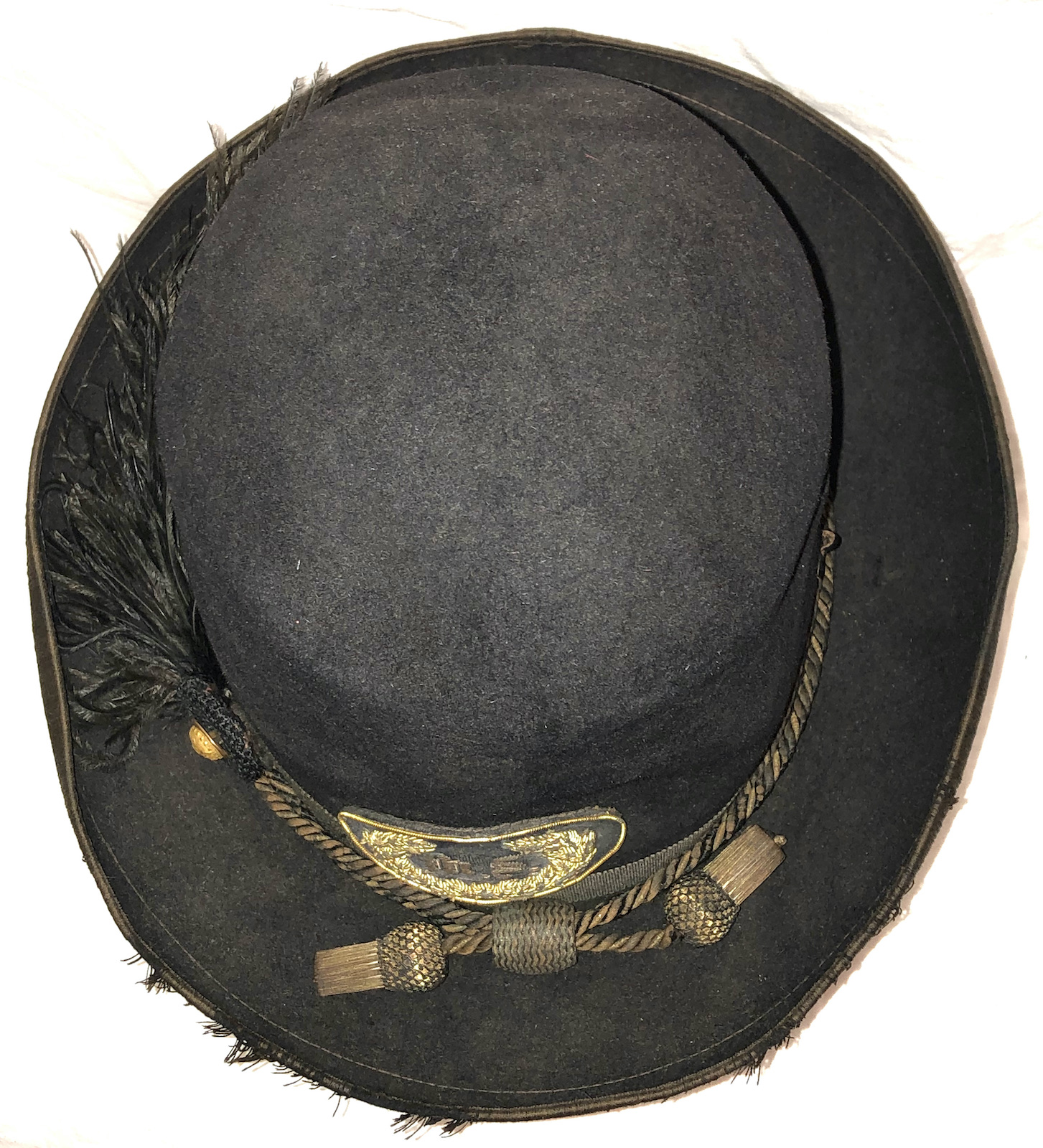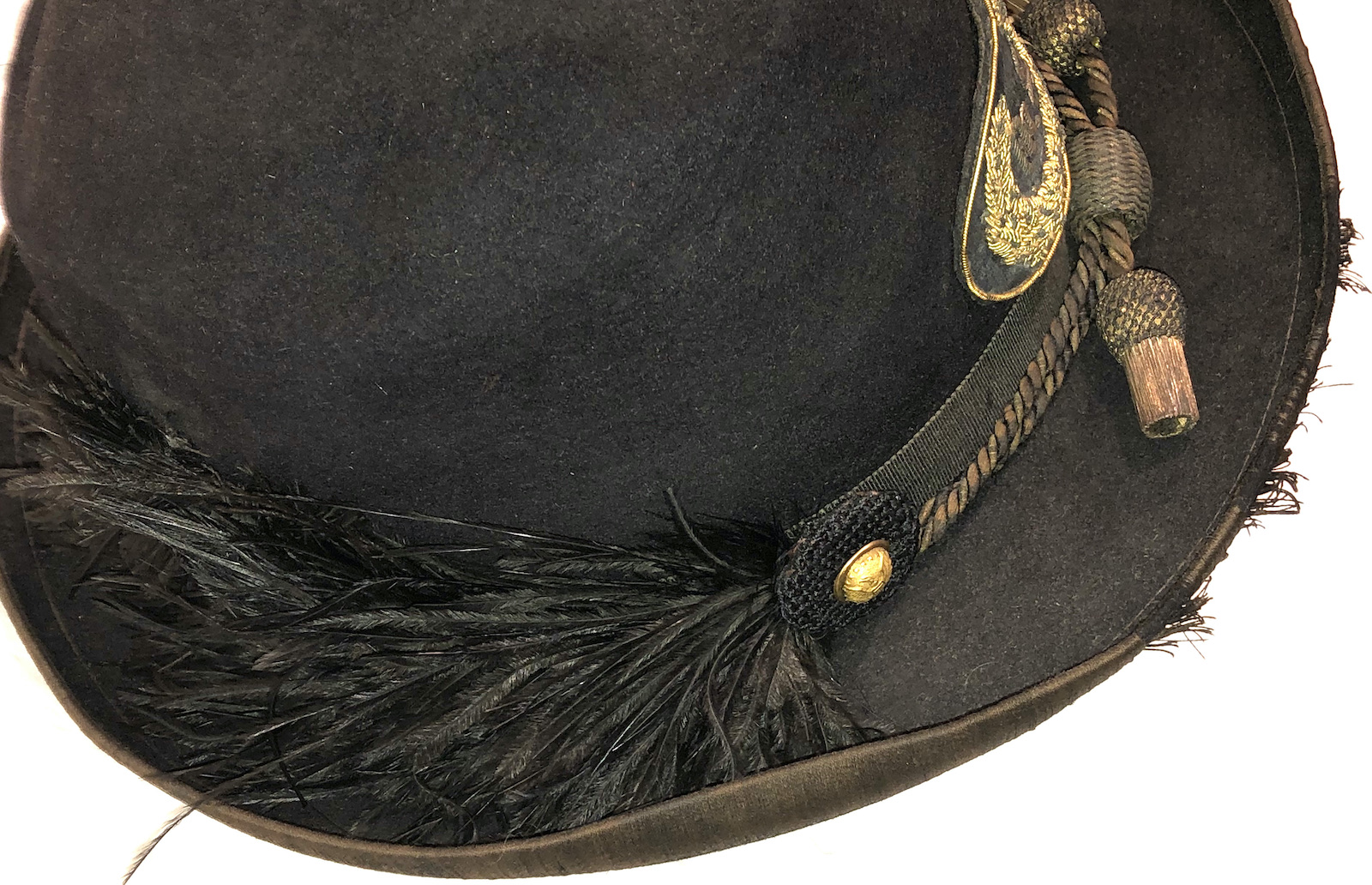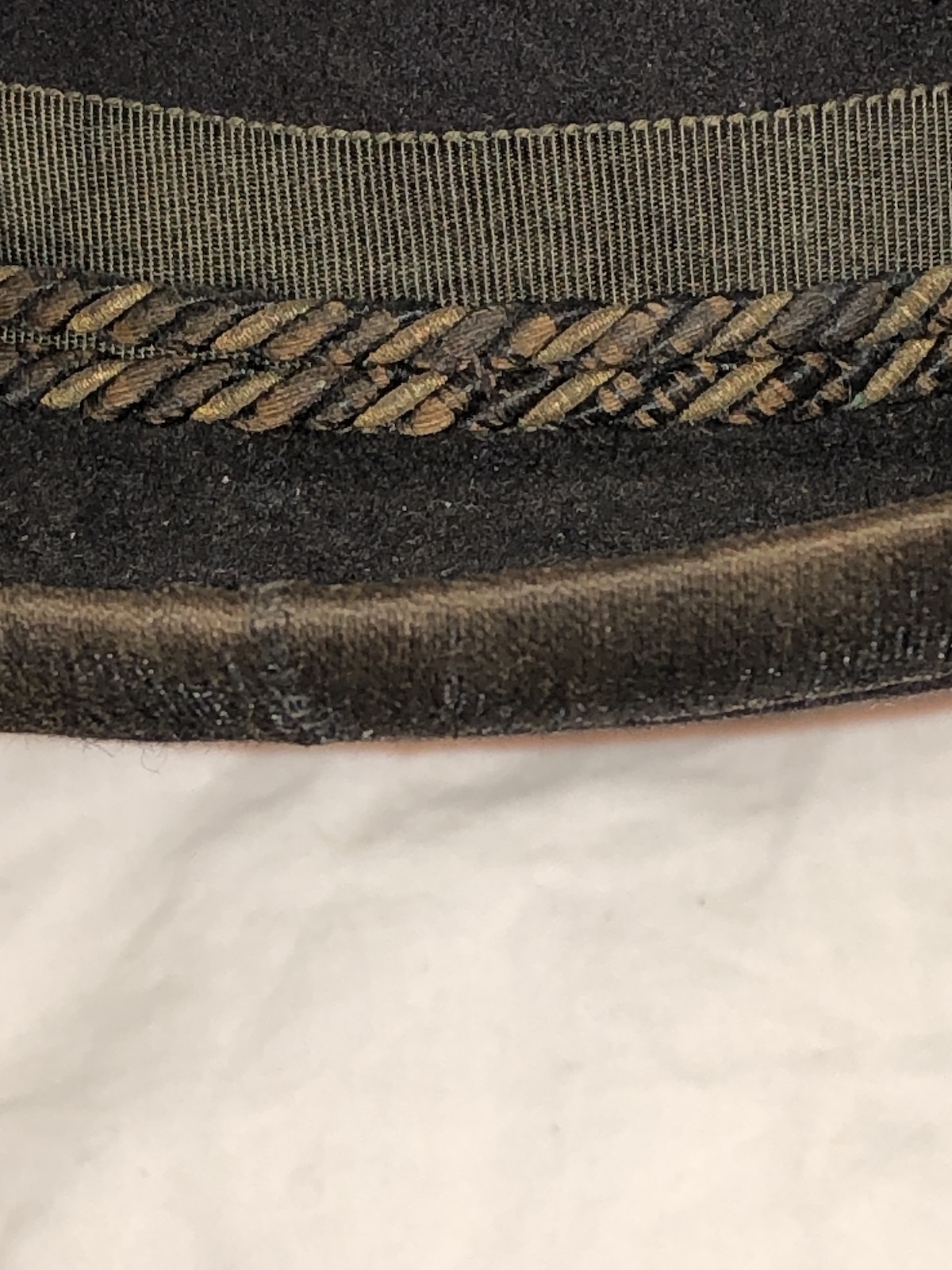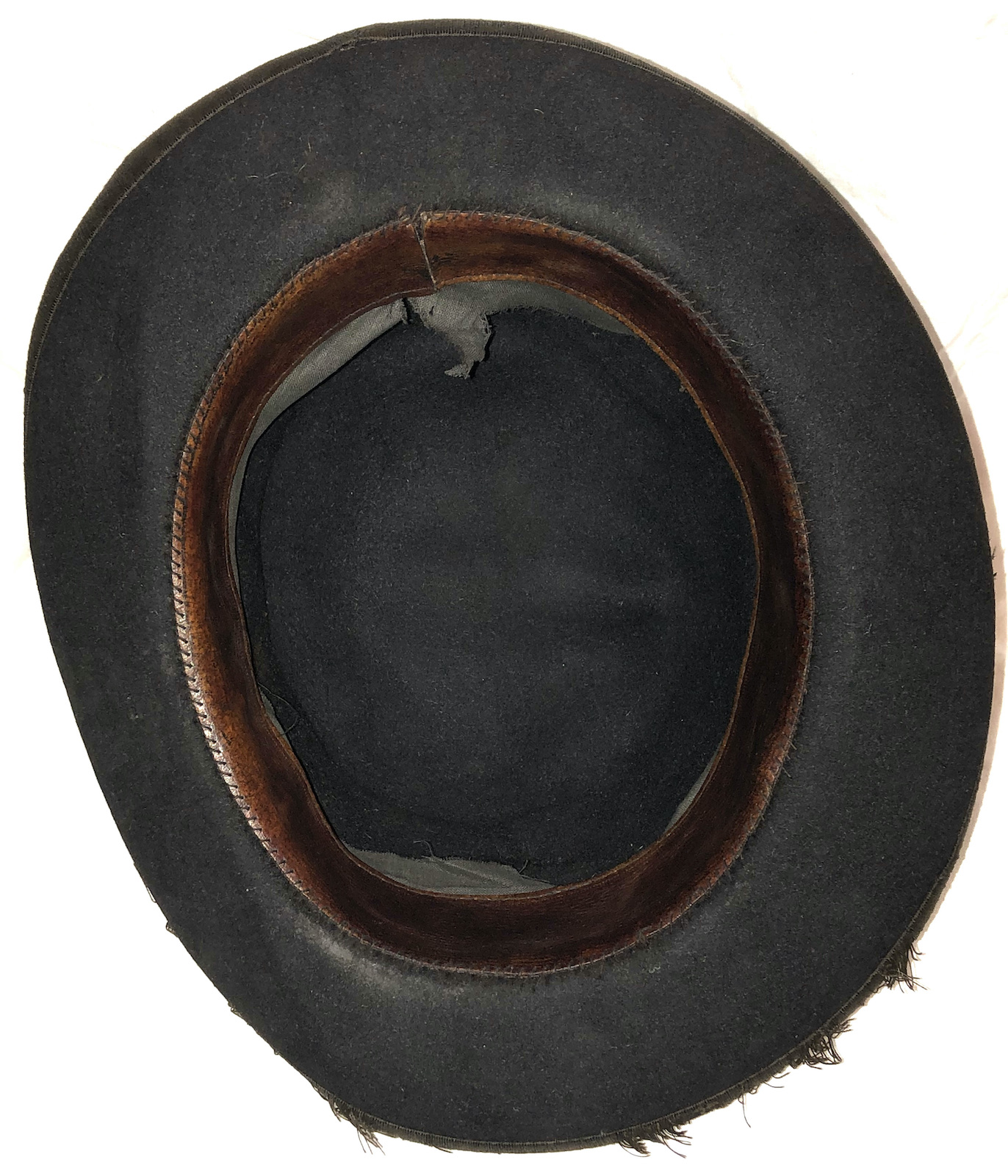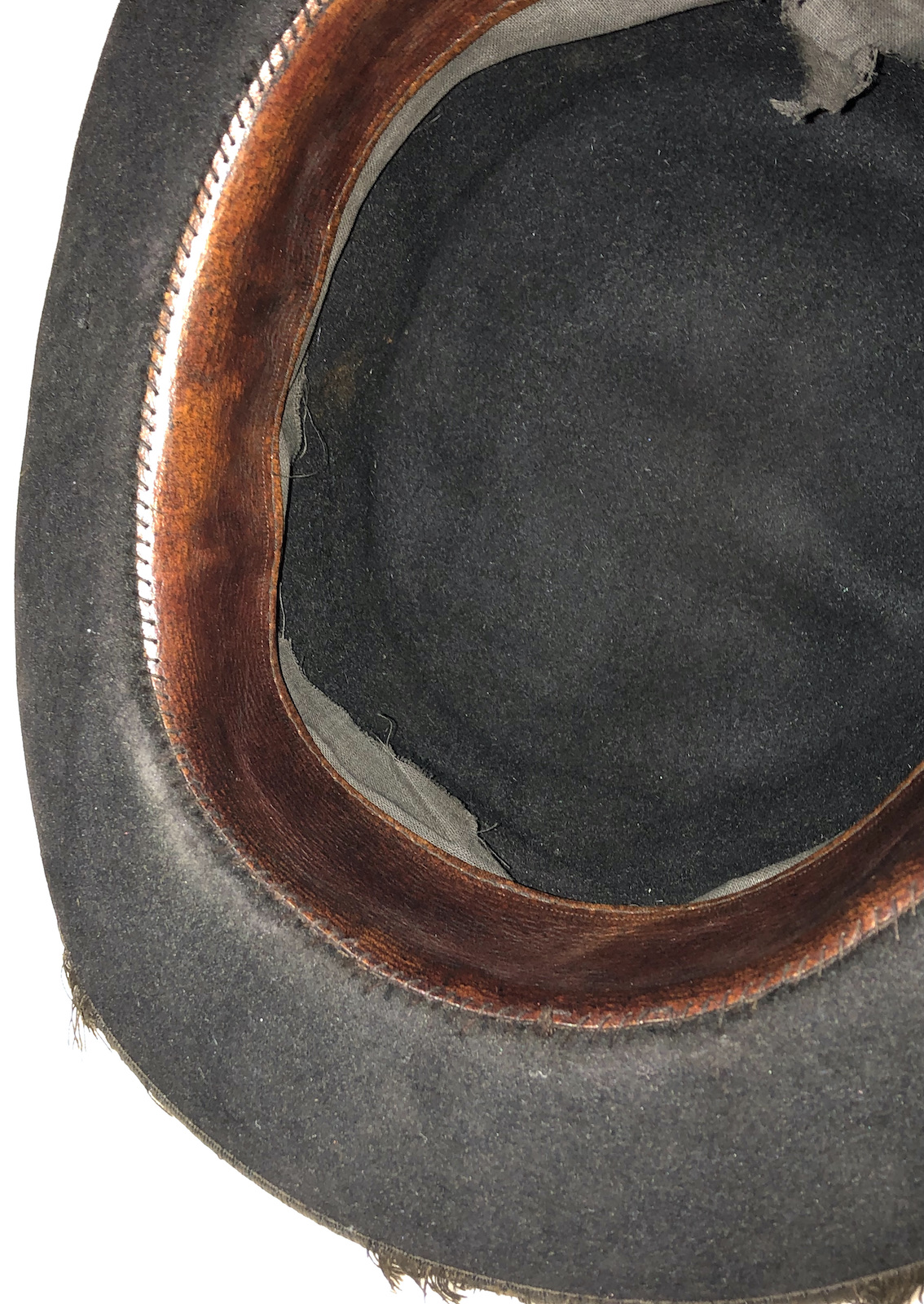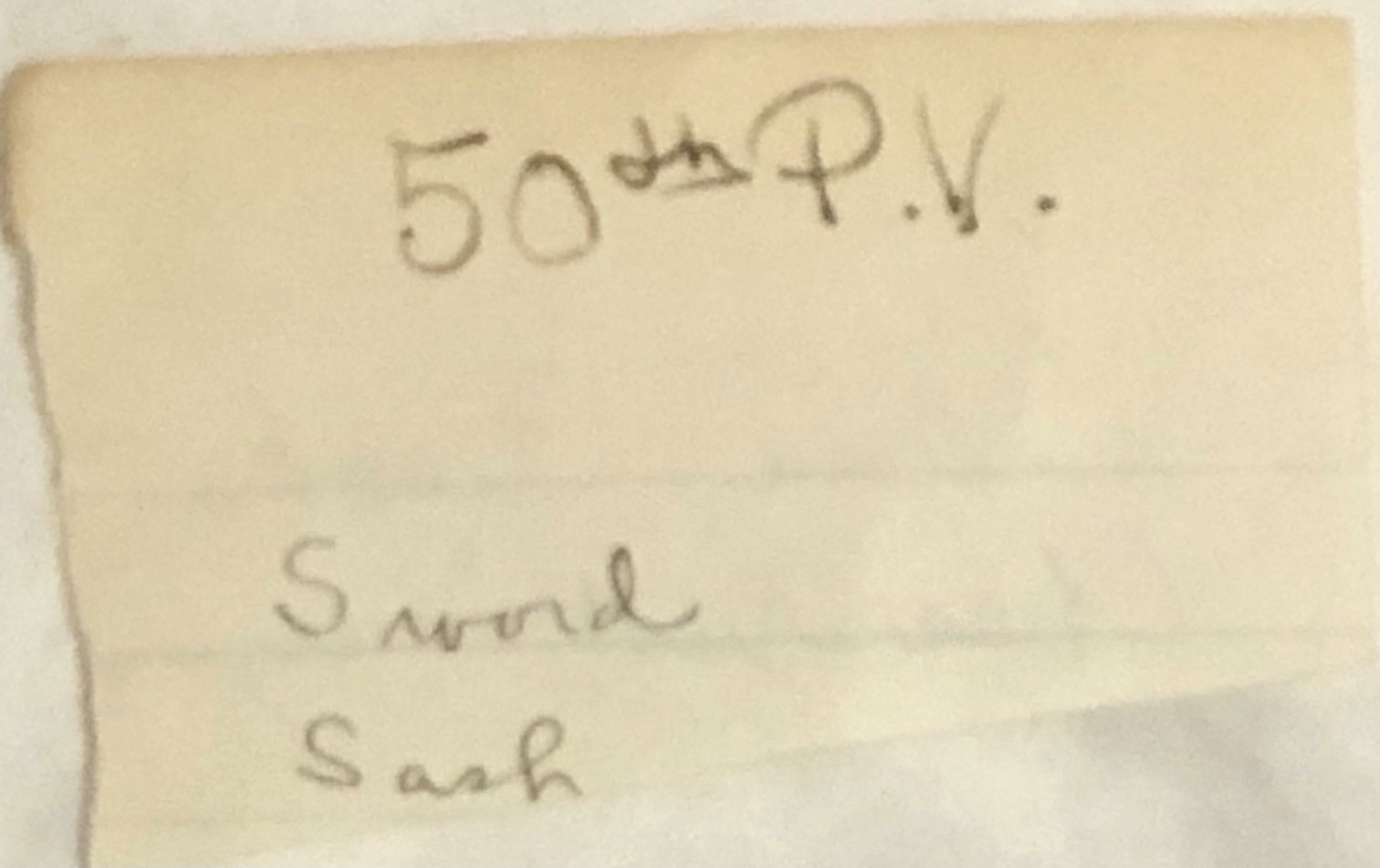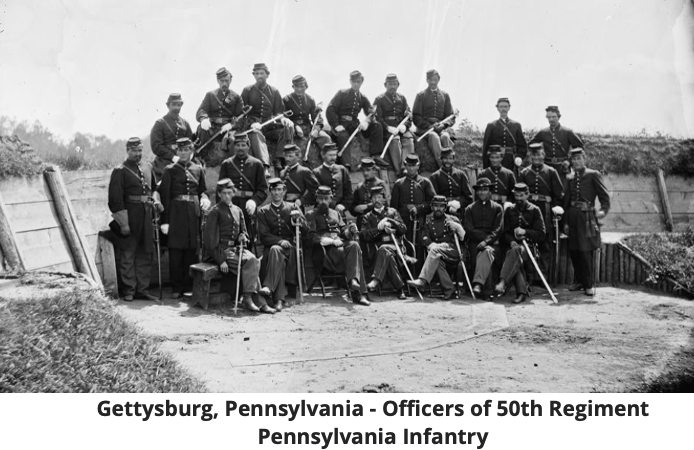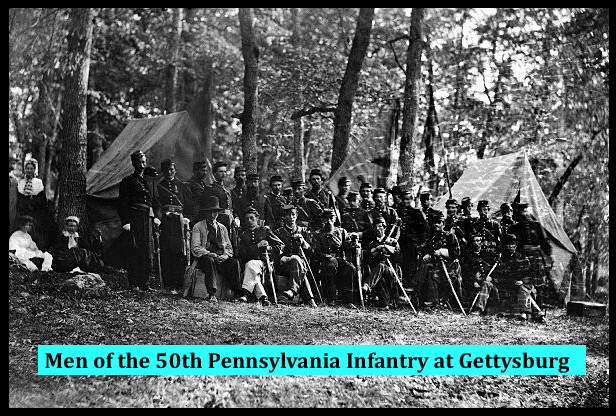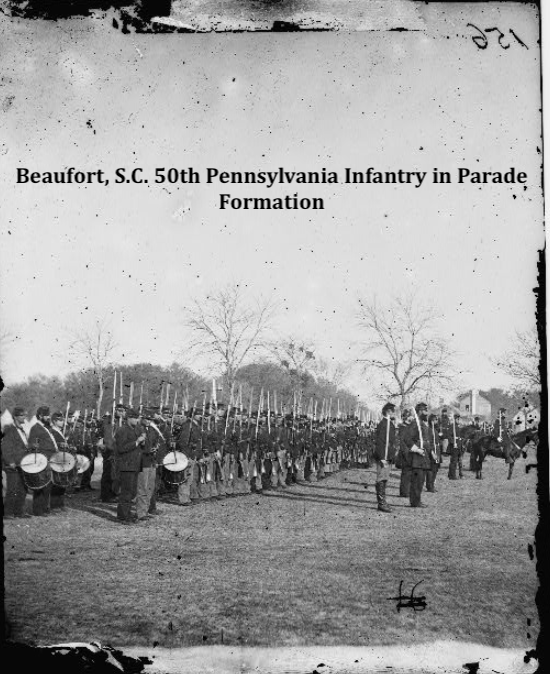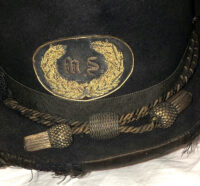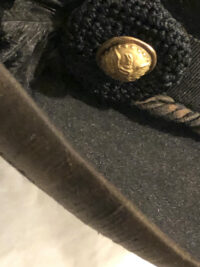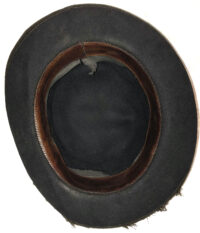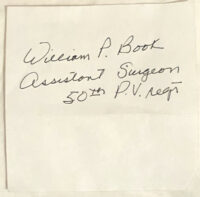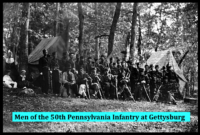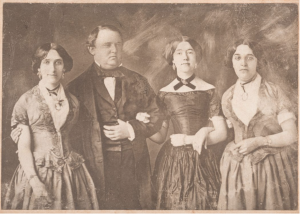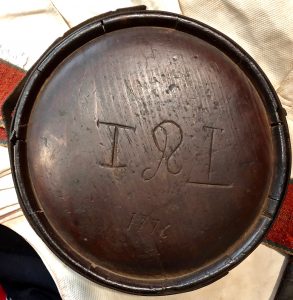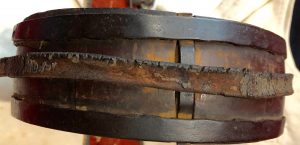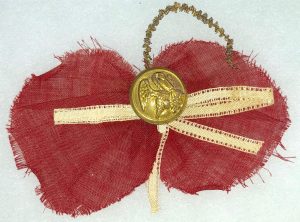CIVIL WAR SURGEON’S SLOUCH HAT ID’D TO ASS’T. SURGEON WILLIAM P. BOOK 50TH PA. INFANTRY
SOLD
CIVIL WAR SURGEON’S SLOUCH HAT ID’D TO ASS’T. SURGEON WILLIAM P. BOOK 50TH PA. INFANTRY – This fine example of a Union Surgeon’s slouch hat exhibits all of the characteristics collectors like to see in an original, period slouch hat:
constructed of a high grade of “mellow” or soft, rabbit felt; black, grosgrain, silk ribbon brim binding; wide, high grade leather sweat band; silk interior lining (only remnants remain in this hat); correct, original to the hat, Medical service branch insignia, Civil War period hat cord, staff button, crewel work rosette and ostrich plume. The hat is in superior condition. Significantly, tucked into the sweat band, when we obtained the hat, was an old, handwritten, in ink, paper tag that, on one said, says:
“William P. Book
Assistant Surgeon”
On the opposite side of this tag is inked:
“50th P.V.
Sword
Sash”
In addition to the above, old tag, we found another descriptive tag, possibly from an early collector; this tag states:
“William P. Book
Assistant Surgeon
50th P.V. regt”
Unfortunately, the sword and sash, mentioned on the back of the old tag, did not accompany the hat. Research indicates that William P. Book, a 30 year old physician from Lawrence County, Pennsylvania, enlisted in August of 1862, as Assistant Surgeon and Field and Staff officer in the 50th Pennsylvania Infantry; he remained in this regiment until the end of September, 1864. The 50th Pa. would see extensive action, during the war, with participation in the following battles: Second Bull Run, South Mountain, Chantilly, Antietam, Fredericksburg, Vicksburg, Spotsylvania Courthouse, Battle of the Crater, Battle of Globe Tavern, Battle of Peeble’s Farm, Battle of the Boydton Plank Road and Battle of Ft. Stedman. As mentioned, Surgeon Book’s rare, original Medical Staff officer’s insignia remains, in good condition, affixed to the front of the hat; the cuff button on the woven rosette, on the side of the hat, is a Federal Staff Officer’s button. This is an important, identified, rare, Union surgeon’s hat, in great condition.
William P. Book
Residence Lawrence County PA; a 30 year-old Physician. Enlisted on 8/1/1862 at Harrisburg, PA as a Asst Surgeon. On 8/2/1862 he was commissioned into Field & Staff PA 50th Infantry He was Mustered Out on 9/30/1864
|
||||||||||||||||||||||||
| Name: | William P Book | |||||||||||||||||||||||
| Enlistment Age: | 30 | |||||||||||||||||||||||
| Birth Date: | abt 1832 | |||||||||||||||||||||||
| Enlistment Date: | 1 Aug 1862 | |||||||||||||||||||||||
| Enlistment Place: | Harrisburg, Pennsylvania | |||||||||||||||||||||||
| Enlistment Rank: | Assistant Surgeon | |||||||||||||||||||||||
| Muster Date: | 2 Aug 1862 | |||||||||||||||||||||||
| Muster Place: | Pennsylvania | |||||||||||||||||||||||
| Muster Company: | S | |||||||||||||||||||||||
| Muster Regiment: | 50th Infantry | |||||||||||||||||||||||
| Muster Regiment Type: | Infantry | |||||||||||||||||||||||
| Muster Information: | Commission | |||||||||||||||||||||||
| Muster Out Date: | 30 Sep 1864 | |||||||||||||||||||||||
| Muster Out Information: | Mustered Out | |||||||||||||||||||||||
| Side of War: | Union | |||||||||||||||||||||||
| Survived War?: | Yes | |||||||||||||||||||||||
| Was Officer?: | Yes | |||||||||||||||||||||||
| Residence Place: | Lawrence County, Pennsylvania | |||||||||||||||||||||||
| Occupation: | Physician | |||||||||||||||||||||||
50th PA Infantry
( 3-years )
| Organized: Camp Curtin, Harrisburg, PA on 9/25/61 Mustered Out: 7/30/65 at Georgetown, DCOfficers Killed or Mortally Wounded: 8 Officers Died of Disease, Accidents, etc.: 4 Enlisted Men Killed or Mortally Wounded: 156 Enlisted Men Died of Disease, Accidents, etc.: 180 (Source: Fox, Regimental Losses) |
| From | To | Brigade | Division | Corps | Army | Comment |
| Oct ’61 | Apr ’62 | 2 | South Carolina Expeditionary Corps | |||
| Apr ’62 | Jul ’62 | Dist of Beaufort | Department of the South | |||
| Jul ’62 | Sep ’62 | 1 | 1 | 9 | Army of Potomac | |
| Sep ’62 | Mar ’63 | 2 | 1 | 9 | Army of Potomac | |
| Mar ’63 | Jun ’63 | 2 | 1 | 9 | Army and Dept of Ohio | |
| Jun ’63 | Jun ’63 | 3 | 2 | 9 | Army and Dept of Ohio | |
| Jun ’63 | Aug ’63 | 3 | 2 | 9 | Department of the Tennessee | |
| Aug ’63 | Apr ’64 | 2 | 1 | 9 | Army and Dept of Ohio | |
| Apr ’64 | Sep ’64 | 2 | 3 | 9 | Army of Potomac | |
| Sep ’64 | Jul ’65 | 2 | 1 | 9 | Army of Potomac | Mustered Out |
Pennsylvania
50th INFANTRY
(3 years)
|
Fiftieth Infantry.-Cols., Benjamin C. Christ, William H. Telford; Lieut.-Cols., Thomas S. Brenholtz, Edward Overton, JR., William H. Telford, Samuel K. Schwenk, Majs., Edward Overton, Jr., Samuel K Schwenk, George W.Brumm. The 50th regiment, recruited in the counties of Berks, Schuylkill, Bradford, Susquehanna, Lancaster and Luzerne, was mustered into the U. S. service at Harrisburg, Oct. I, I86I, for three years. It left Camp Curtin the next day for Washington, after which it moved to Annapolis and joined the expedition to South Carolina, being assigned to Stevens’ brigade. The command camped near Hilton Head until Dec. 6, when it occupied Beaufort and had a slight skirmish with the enemy the following day. On Jan. I, 1802, the brigade crossed the Coosaw river and captured a fort. In May an attempt was made to destroy the railroad bridge at old Pocotaligo, which was unsuccessful in spite of the gallantry of the regiment. On July 12 it embarked for Fortress Monroe and on its arrival was attached to the 9th corps and ordered to join Gen. Pope on the Rapidan. Several skirmishes ensued at the fords of the Rapidan and Rappahannock. At the second Bull Run, Chantilly, South mountain and Antietam it fought gallantly and sustained heavy losses. It was present at Fredericksburg but not in the battle. It was then ordered to join the Army of the Ohio, advanced to Vicksburg, where it was posted on Haines Bluff, and after the siege followed Gen. Sherman to Jackson, where it was engaged and lost its brave Lieut.-Col. Brenholtz. In the southern campaign the men suffered much from malaria and on Aug. IO, such as were able returned to Kentucky. They were active at the battle of Blue Springs, Tenn., in October and in November at Lenoir Station and Campbell’s station, near Knoxville, and the attack on Fort Sanders. The regiment shared in the pursuit of Longstreet as far as Blaine’s cross-roads, when it was ordered to Nicholasville and the reenlisted men were sent home on veteran furlough. In spite of the hardships of the winter nearly the entire regiment reenlisted and on March 20, 1864, reported at Annapolis, the rendezvous of the 9th corps. The 50th was attached to the 2nd brigade, Ist division, of this corps, which joined the Army of the Potomac at the Rapidan on May 5, and engaged at the Wilderness, Spottsylvania, the North Anna river and Cold Harbor. At Petersburg it was in support of the troops that made the assault after the mine explosion; joined in the engagement at the Weldon railroad, and in the final assault on the city, April 2, 1865. About the middle of April it proceeded to Washington and remained there until June 30, when it was ordered to Gettysburg to represent the infantry of the Union army at the corner stone ceremonies of the National Monument, July 4, and returned to camp at Georgetown, where it was mustered out on July 31, 1865. |
| 50th Regiment Pennsylvania Volunteer Infantry | |
| Active | October 1, 1861 – July 30, 1865 |
| Country | United States of America |
| Allegiance | Union |
| Branch | Infantry |
| Engagements | First Battle of Pocotaligo Battle of Groveton Second Battle of Bull Run Battle of Chantilly Battle of South Mountain Battle of Antietam Battle of Fredericksburg Siege of Vicksburg Jackson Expedition Knoxville Campaign Battle of the Wilderness Battle of Spotsylvania Court House Battle of North Anna Battle of Totopotomoy Creek Battle of Cold Harbor Siege of Petersburg Battle of the Crater Battle of Globe Tavern Battle of Peeble’s Farm Battle of Boydton Plank Road Battle of Fort Stedman Appomattox Campaign Third Battle of Petersburg |
The 50th Regiment Pennsylvania Volunteer Infantry was an infantry regiment that served in the Union Army during the American Civil War.
Service
The 50th Pennsylvania Infantry was organized in Harrisburg, Pennsylvania and mustered in October 1, 1861 for a three-year enlistment under the command of Colonel Benjamin C. Christ. The regiment was initially armed with Model 1816 flintlock muskets converted to percussion, within a few months they were replaced with .54 caliber Austrian Lorenz Rifles. In 1863, the 50th Pennsylvania were forced to replace them with Model 1861 Springfield rifles due to logistics reasons (the regiment was the only one in the IX Corps that required .54 caliber ammunition). The soldiers were unhappy with this as they considered the Lorenz rifles a more-than-adequate weapon that also weighed less than the Springfield rifle.
The regiment was attached to Stevens’ Brigade, W. T. Sherman’s South Carolina Expedition, to April 1862. District of Beaufort, South Carolina, Department of the South, to July 1862. 1st Brigade, 1st Division, IX Corps, Army of the Potomac, to September 1862. 2nd Brigade, 1st Division, IX Corps, Army of the Potomac, to April 1863, and Army of the Ohio to June 1863. 3rd Brigade, 2nd Division, IX Corps, Army of the Tennessee, to August 1863. 2nd Brigade, 1st Division, IX Corps, Army of the Ohio, to April 1864. 2nd Brigade, 3rd Division, IX Corps, Army of the Potomac, to September 1864. 2nd Brigade, 1st Division, Army of the Potomac, to July 1865.
The 50th Pennsylvania Infantry mustered out July 31, 1865.
Detailed service
Left Pennsylvania for Washington, D.C., October 2, 1861, then moved to Annapolis, Md., October 9. Sherman’s expedition to Port Royal, S.C. October 21-November 7, 1861. Sailed on the steamer Winfield Scott and shipwrecked off the coast of North Carolina. Occupation of Beaufort, S.C., December 6. Port Royal Ferry, Coosaw River, January 1, 1862. Duty at Port Royal Island, S.C., until July 1862. Barnwell’s Island, S.C., February 10 (Company D). Pocotaligo May 29. Camp Stevens June 7. Moved to Hilton Head, S.C., then to Newport News, Va., July 14-18, then to Aquia Creek and Fredericksburg, Va., August 3-6. Operations in support of Pope August 6-16. Pope’s campaign in northern Virginia August 16-September 2. Sulphur Springs August 24. Battle of Groveton August 29. Second Battle of Bull Run August 30. Battle of Chantilly September 1. Maryland Campaign September 6-24. Battle of South Mountain, Md., September 14. Battle of Antietam September 16-17. March to Pleasant Valley September 19-October 2, and duty there until October 25. Movement to Falmouth, Va., October 25-November 19. Battle of Fredericksburg December 12-15. Burnside’s 2nd Campaign January 20-24, 1863. At Falmouth until February 12. Moved to Newport News February 12-14, then to Kentucky March 21-26. Duty at Paris, Ky., until April 27. Moved to Nicholasville, Lancaster, and Stanford April 27-29, then to Somerset May 6-8, then through Kentucky to Cairo, Ill., June 4-10, and to Vicksburg, Miss., June 14-17. Siege of Vicksburg, Miss., June 17-July 4. Advance on Jackson, Miss., July 5-10. Siege of Jackson July 10-17. At Milldale until August 12. Moved to Covington, Ky., August 12-23. Burnside’s campaign in eastern Tennessee August to October. Action at Blue Springs, Tenn., October 10. Clinch Mountain October 27. Knoxville Campaign November 4-December 23. Campbell’s Station November 16. Siege of Knoxville November 17-December 5. Pursuit of Longstreet’s army to Blain’s Cross Roads December 5-26. Reenlisted at Blain’s Cross Roads January 1, 1864. Moved to Annapolis, Md., April 1864. Rapidan Campaign May 4-June 12. Battle of the Wilderness May 5-7. Spotsylvania May 8-12. Ny River May 9. Spotsylvania Court House May 12-21. Assault on the Salient May 12. North Anna River May 23-26. Ox Ford May 24. Line of the Pamunkey May 26-28. Totopotomoy May 28-31. Cold Harbor June 1-12. Bethesda Church June 1-3. Before Petersburg June 16-18. Siege of Petersburg June 16, 1864 to April 2, 1865. Mine Explosion, Petersburg, July 30, 1864. Weldon Railroad August 18-21. Poplar Springs Church or Peeble’s Farm September 29-October 2. Reconnaissance on Vaughan or Squirrel Level Road October 8. Boydton Plank Road, Hatcher’s Run, October 27-28. Fort Stedman March 25, 1865. Appomattox Campaign March 28-April 9. Assault on and fall of Petersburg April 2. Pursuit of Lee to Burkesville April 3-9. Moved to City Point, then to Washington, D.C., April 21-28. Grand Review of the Armies May 23.
Casualties
The regiment lost a total of 348 men during service; 8 officers and 156 enlisted men killed or mortally wounded, 4 officers and 180 enlisted men died of disease.
Commanders
- Colonel Benjamin C. Christ – promoted to brevetbrigadier general August 1, 1864
- Colonel William H. Telford
- Lieutenant ColonelThomas S. Brenholtz – commanded at the Second Battle of Bull Run until wounded in action
- MajorEdward Overton, Jr. – commanded at the Second Battle of Bull Run after Ltc Brenholtz was wounded; commanded at the Battle of Antietam until wounded in action
- Major Samuel K. Schwenk – commanded at the Battle of Fort Stedman
- CaptainWilliam H. Diehl – commanded at the Battle of Antietam after Maj Overton was wounded
Notable members
- SergeantCharles Brown, Company C – Medal of Honor recipient for action at the Battle of Globe Tavern
- CorporalHenry Hill, Company C – Medal of Honor recipient for action at the Battle of the Wilderness




